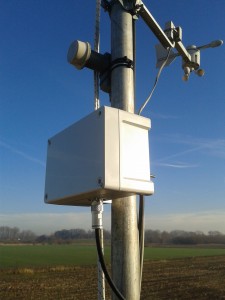HB9CV-in-a-box antenna for 23cm
The HB9CV has been a popular antenna for decades, especially on the 2m band where it is commonly used for direction finding (foxhunt). Others create arrays of HB9CV antennas for DXing. Since I needed a simple antenna for 23cm (to uplink to the local ATV repeater PI6ATV) I thought it would be nice to use this HB9CV design.
There are several designs available, I used a description of DH2PA for no particular reason (it was simply one of the first usable designs I found). If you don’t want to build it yourself, you can buy one on some radio stores or a local radio market.
Some specifications of the HB9CV antenna (according to “Rothammels Antennenbuch”):
- Gain: 4.2 dBd (+/- 0.2)
- 3dB angle (E plane): 68 degrees
- 3dB angle (H plane): 130 degrees
- Front-to-back ratio: 20 dB
- Impedance: 50 ohm
I used thick copper wire to build the antenna itself, and thin copper wire to create the match/feeder. Everything is simply soldered together. I used to build antennas for HF and VHF, so with these small dimensions I continuously thought I was building some model. The capacitor has a range of 2-6 pF and is used to match the antenna impendance.
The antenna is a bit vulnerable to weather conditions and other external influences, so I put it into a plastic box. If you want to do this, remember that the box must be “RF friendly”. If you’re not sure, put the box into your microwave for 2 minutes along with a glass of water, the box should remain cold. The antenna itself is fixed by using a small piece of semi-rigid, connected to the HB9CV at one side, and a N flange jack at the other side which is mounted through a hole in the box.
After a final test the box is mounted to one of my antenna poles, close to the LNC which I use to receive the 3cm output of the ATV repeater.
Down here you’ll see some pictures which show you how I made this antenna.
This article was also published in:
![[image]](https://www.pa3hcm.nl/wp-content/uploads/2013/12/enh-logo1.jpg)


![[image]](https://www.pa3hcm.nl/wp-content/uploads/2014/01/20140112_112049-e1389524173837.jpg)
Beste Ernest,
In hoeverre heeft inbouw in een (ABS) behuizing invloed op de verstemming van de antenne?
Peter,
I haven’t measured it yet (have no measurement gear for 1.3 GHz) but I tested the box in the microwave oven and it didn’t heat up at all. So I expect the influence is low to none.
73,Ernest PA3HCM
Hi Ernest
Can you supply the dimensions of the antenna elements and feedpoint matching element?
73, Andrew VK1AD (Canberra, Australia)
Andrew,
Just click on the DH2PA link and you’ll find a PDF including the dimensions. Or use this direct link:
http://dh2pa.darc.de/projekte/HB9CV_23cm.pdf
73, Ernest PA3HCM
Thanks Ernest, much appreciated.